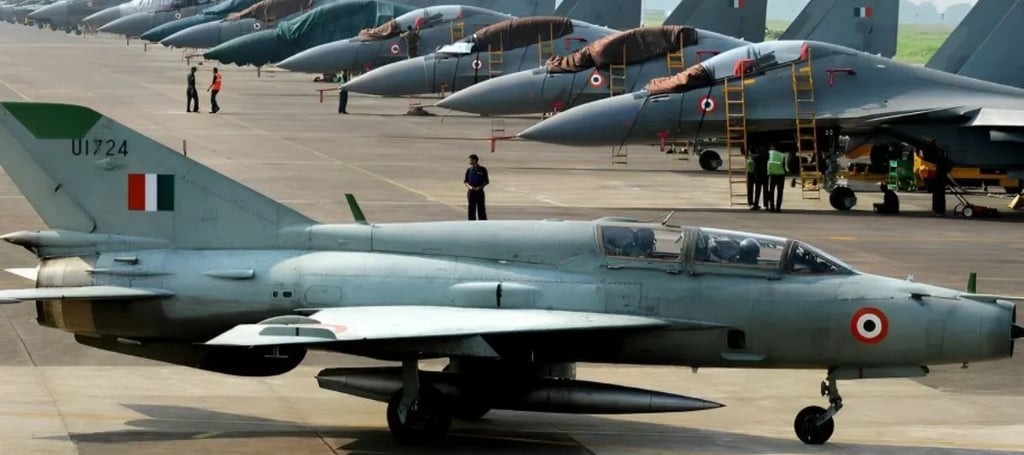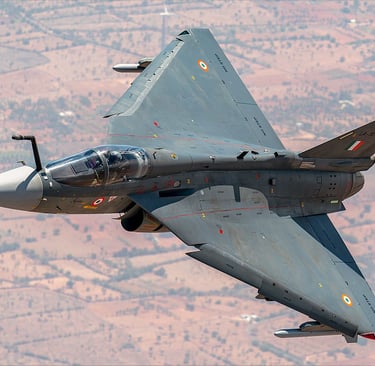Indian Air Force’s Long Battle with Safety: 534 Aircraft Crashes and 152 Pilots Lost in 30 Years
Over the past 30 years, the IAF has faced a worrying number of aircraft accidents. Since the early 1990s, the IAF has lost more than 534 aircraft and 152 pilots.
IN BRIEF
Thinkbrief
7/14/20254 min read


The Indian Air Force (IAF) is one of the most respected and powerful air forces in the world. It has a proud history of defending India’s skies. However, over the past 30 years, the IAF has faced a worrying number of aircraft accidents. Since the early 1990s, the IAF has lost more than 534 aircraft and 152 pilots. These numbers reflect a serious safety concern within the force. In this essay, we will explore the timeline of these accidents, the human and economic costs, the reasons behind these crashes, and how the IAF can address these challenges moving forward.
Timeline and Scale of the Problem
The Indian Air Force has seen a significant number of aircraft accidents over the years. During the 1990s, the IAF lost around 20–30 aircraft annually. This was a difficult time for the Air Force with some years seeing even higher losses. In the 2000s, the situation improved slightly with the number of accidents falling to 10–20 per year. In recent years, the numbers have reduced further but there are still concerns. The IAF has experienced 534 crashes in the last 30 years and the loss of 152 pilots is a tragic reminder of the risks involved in military aviation.
One of the main reasons for this high number of accidents is the age of many of the IAF’s aircraft. The MiG-21, a Soviet-era jet, became notorious for its high accident rate. Over half of the MiG-21 fleet was involved in accidents. Between 1991 and 2002, the IAF lost 116 MiG-21s, which earned it the nickname “flying coffin” due to its safety record. Despite efforts to modernize the fleet, the MiG-21 continued to be a major part of the IAF’s operations for many years, contributing to the overall number of accidents.
Human and Economic Costs
The human cost of these accidents is immense. The loss of 152 pilots is a tragedy for the IAF and their families. Pilots spend years training and honing their skills, and losing one is a blow not only to their loved ones but also to the entire Air Force. Every pilot is an essential part of the force, and their death creates a gap that takes time and resources to fill. These losses also impact the morale of the force. The death of a colleague is always deeply felt in a close-knit community like the IAF.
The economic cost of these accidents is equally significant. The loss of 534 aircraft over the years represents a massive financial burden. Aircraft are expensive to maintain and operate, and replacing them is a costly process. The IAF spends a significant portion of its budget on purchasing, maintaining, and upgrading aircraft. Losing them in accidents not only impacts the operational capabilities of the Air Force but also puts a strain on its budget. Furthermore, the training and recruitment process for pilots is expensive. When a pilot is lost in an accident, the IAF must invest in training a replacement, which takes years.
Reasons and Challenges Behind Aircraft Accidents
There are several reasons behind the high number of aircraft accidents in the Indian Air Force. One of the main factors is the aging fleet. Aircraft like the MiG-21 were designed decades ago and have outlived their useful lives. These aircraft are prone to mechanical failures and accidents due to wear and tear. Despite efforts to upgrade and modernize the fleet, many of these older aircraft are still in operation, which increases the chances of accidents.
Another major factor contributing to the accidents is human error. While the IAF trains its pilots rigorously, mistakes still happen. Pilots, especially younger or less experienced ones, can sometimes make errors under stress or in difficult conditions. These mistakes, while often small, can lead to catastrophic results when flying complex machines like fighter jets or helicopters. Although the IAF has made efforts to improve training and reduce human error, it remains one of the leading causes of accidents.
Additionally, the quality of maintenance and the availability of spare parts has been a challenge. Aircraft require regular and thorough maintenance to stay operational and safe. However, delays in repairs or the lack of spare parts can lead to equipment failures that cause accidents. While the IAF has made significant strides in improving its maintenance procedures, these challenges persist, particularly with older aircraft that require specialized parts and attention.
Lastly, the IAF also faces challenges related to budget and political constraints. Modernizing the fleet with newer aircraft is expensive and often takes years. The IAF is sometimes forced to extend the life of older aircraft longer than they should be, which leads to safety risks.
How to Fix the Problem
To address the issue of aircraft accidents, the Indian Air Force needs a comprehensive strategy that focuses on both short-term and long-term solutions. First and foremost, the IAF must continue to modernize its fleet by phasing out older aircraft like the MiG-21 and replacing them with more advanced and reliable models. Newer aircraft such as the Rafale jets and upgraded versions of the Su-30MKI are a step in the right direction. Expediting this modernization process is essential for improving safety and operational readiness.
In addition to modernizing the fleet, the IAF must invest further in pilot training. While IAF pilots are among the best-trained in the world, it is important that they receive continuous and updated training. This includes not only the basics of flying but also how to handle emergency situations and difficult conditions. Simulation technology can be a useful tool to improve training without putting actual aircraft at risk. By ensuring that pilots are prepared for all situations, the IAF can reduce the risk of human error.
Maintaining the aircraft is equally important. The IAF must prioritize timely and effective maintenance to ensure that no aircraft is flown unless it is in top condition. Maintenance crews should be adequately trained and equipped to deal with any issues that arise. Having a reliable supply of spare parts is also essential to keeping older aircraft in service safely.
Finally, the IAF should continue to improve its safety culture. This means creating an environment where safety is the top priority and where all personnel, from pilots to ground staff, are held accountable for their roles in preventing accidents. Regular safety audits and reviews of accident data can help identify areas for improvement.
Conclusion
The Indian Air Force’s history of aircraft accidents over the past 30 years is a tragic reminder of the risks involved in military aviation. The loss of 152 pilots and 534 aircraft has had a profound impact on the IAF, both in terms of operational readiness and morale. However, the IAF has made significant strides in improving safety, and with continued focus on modernization, better training, and improved maintenance, it can reduce the number of accidents in the future. Addressing these issues is not only essential for the safety of the personnel but also for the strength and effectiveness of the Indian Air Force as a whole

